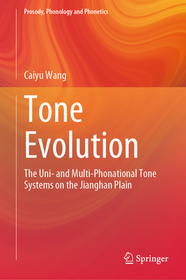
Tone Evolution
The Uni- and Multi-Phonational Tone Systems on the Jianghan Plain
Series: Prosody, Phonology and Phonetics;
- Publisher's listprice EUR 117.69
-
48 811 Ft (46 487 Ft + 5% VAT)
The price is estimated because at the time of ordering we do not know what conversion rates will apply to HUF / product currency when the book arrives. In case HUF is weaker, the price increases slightly, in case HUF is stronger, the price goes lower slightly.
- Discount 20% (cc. 9 762 Ft off)
- Discounted price 39 049 Ft (37 190 Ft + 5% VAT)
Discounted price for customers subscribed to our weekly newsletter.
Subcribe now and take benefit of a favourable price.
Subscribe
Subcribe now and take benefit of a favourable price.
Subscribe
48 811 Ft

Availability
printed on demand
Why don't you give exact delivery time?
Delivery time is estimated on our previous experiences. We give estimations only, because we order from outside Hungary, and the delivery time mainly depends on how quickly the publisher supplies the book. Faster or slower deliveries both happen, but we do our best to supply as quickly as possible.
Product details:
- Edition number 2024
- Publisher Springer Nature Singapore
- Date of Publication 23 August 2024
- Number of Volumes 1 pieces, Book
- ISBN 9789819700011
- Binding Hardback
- No. of pages241 pages
- Size 235x155 mm
- Language English
- Illustrations XXI, 241 p. 214 illus., 141 illus. in color. Illustrations, black & white 589
Categories
Long description:
This book provides a start of defining the uni- and multi-phonational tone systems of geographically-connected dialects under a phonation-pitch tonal model. It also demonstrates an interpretation of the contemporary ongoing tonal variations and varieties from the perspective of language evolution. Acoustic data are collected from five adjacent counties on the Jianghan Plain in China, where two varieties of Southwestern Mandarin and one variety of Gan Dialect are spoken. Falsetto and breathy phonations are applied in this area for phonological distinction, and thus the modal-only dialects co-occur with the di-phonational (falsetto and modal) and tri-phonational (falsetto, modal, and breathy) ones. The acoustic and perceptual analyses are conducted to define tones under the Multi-Register Four-Level Tonal Model, a frame considering both pitch and phonation for the definition of tones. The synchronic variations and varieties within and across speakers/dialects are interpreted in the dynamic interplay of tones mainly governed by phonetic and phonological reasons. The inner-system tonal differences of individual dialectal varieties together with the general distributive patterns of tones in this area are evaluated to determine the paths of tone evolution.
Fresh for it exploring the definition and linguistic meaning of the dynamic modal- and non-modal tones, the book benefits researchers with data, research methods, and insight and helps the language teachers and learners understand and learn tones with what the lexical tones really are. The book is also written for the readers curious of tones and tone languages.
More
Table of Contents:
Chapter 1 Introduction.- Chapter 2 The Jianghan Plain and the Co-occurrence of Uni- and Multi-Register Tone Systems.- Chapter 3 Songzi Dialects: Uni- and Di-register Tone Systems.- Chapter 4 Shayang: Uni- and Di-register Tone Systems.- Chapter 5 Gong’an: Changing Tone Systems.- Chapter 6 Shishou: Systems of Five to Six Tones Depending on the Moving Qingqu.- Chapter 7 Jianli: Tri-, Di-, and Uni-register Tone Systems.- Chapter 8 Definition and Evolution of the Tone Systems in Uni- and Multi-Phonational Languages Bibliography and References.




